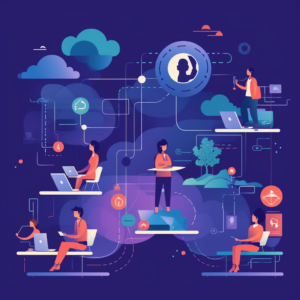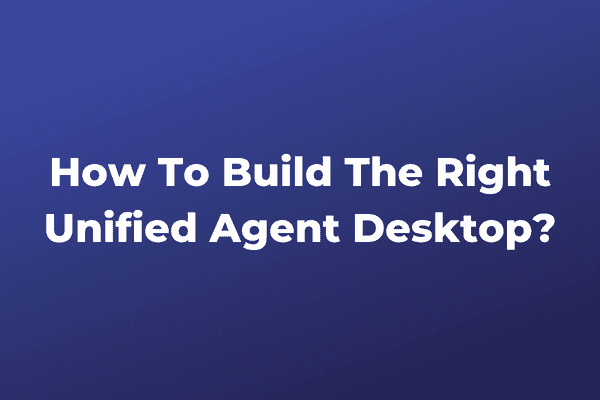Managing different solutions separately creates unnecessary silos and leads to conversations that don’t make sense, hurting the agent’s performance. As the public face of your brand, agents are greatly aided by a unified agent desktop that makes it easy for them to interact with customers.
Of course, seasoned contact center professionals will smile with nostalgia, remembering the good old days when the trusted landline call was the only communication channel an agent had to deal with.
Fast forward a couple of decades into the present day, and we get a completely different picture. Why? Well, let’s say the internet happened, and since then, the agent work volume is only going up. Just think about the emergence of new communication channels, mobile devices, social media, VoIP, rich data, and so on…
In short, there is a strong connection between technology and the agent experience, especially in today’s omnichannel environment. The way to tackle this issue is to create a contact center infrastructure that can simplify procedures and centralize data. And here’s where the unified agent desktop technology comes in.
Many call centers have a lot of different, complicated systems that are hard for agents to figure out, let alone keep their attention on what’s important: the customer. This can lead to unhappy customers, less work getting done, wasted time on the phone, and extra costs for the business in the future.
The notion of a unified agent desktop has become an essential cog in the wheel of an efficient contact center. This singular platform embodies a multitude of functionalities, streamlining tasks for improving agent performance. In this article, we shed light on the components of an effective unified agent desktop and its significance in modern customer service settings.
We will look at the key features and the impact Unified Agent Desktop systems have on the broader contact center productivity.
Key Points:
- Unified Agent Desktop streamlines procedures and links multiple tools with customer data
- Unified Agent Desktop is one of the critical components to call center automation
- The unified agent desktop is not a meaningless or added tool; it is essential for call center productivity
Why should your call center have a unified agent desktop? Why is it necessary?
Consider it like a well-organized toolbox. Having all the necessary tools in one place boosts efficiency, reduces errors, and leads to improved customer service quality. Plus, it alleviates stress for agents, increasing job satisfaction.
Here are some key reasons why it’s a good idea to consolidate all your different solutions and keep the agent desktop as the only place to manage everything:
Integrated communication — with a unified agent desktop, agents can text, call, instant message, and even chat from the same screen to get important information, effectively making all your communication more efficient and effective.
- Rapid provisioning— with one login, agents can instantly connect to your call center without creating a complex login process or entering any credentials each time. This means you can get the agent on the phone as fast as possible without wasting their time.
- Simplified agent management— a unified agent desktop will allow you to see all your agents across every service, freeing up time to focus on things that matter, like problem resolutions.
- Easy to use— with a unified agent desktop, agents can quickly get in touch with customers using various communication tools. For example, you can quickly push notifications and create one-click on-call hotlines to manage complaints, engage with customers, or connect with service agents.
Efficiency and consistency are the cornerstones of successful call centers. A unified agent desktop simplifies complex processes, automates repetitive tasks, and ensures consistent access to accurate data across channels. This not only boosts productivity but also enables better decision-making, faster issue resolution, and a more streamlined customer journey. – Brad Butler, Contact Center Software Consultant @ NobelBiz
What makes a great unified agent desktop?
What is a Unified Agent Desktop?
Have you ever juggled too many balls at once? It’s tricky, right? Imagine a call center agent having to switch between different platforms and tools to service a customer – it’s just as challenging! A Unified Agent Desktop is the superhero that rescues agents from this predicament. It is a platform that consolidates all necessary tools, systems, and data into one user-friendly interface.

For call centers, the Unified Agent Desktop is a solution that streamlines procedures and links multiple software with customer data, allowing your agents to focus on customer requirements and improve brand value with each interaction.
Unified Agent Desktop features case and incident management, call routing, web chat, social media, messaging, and email interaction, as well as a knowledge base for agents and customers.
A great unified agent desktop enables the following:
- To successfully react to consumer inquiries with a single view of pertinent data, eliminate data silos, and remove channel silos.
- Processes may be optimized, and efficiency increased through dynamic routing according to customer demands.
- Reduce expenses by aligning more closely with your call center demands with quick deployment and simple integrations.
- Provide your call center agents and supervisors with real-time dashboards and KPIs to enhance customer understanding.
- User-friendly, easy-to-manage software may save training time and improve quality.
- Gain a more profound knowledge of where requests are from to enhance operations sustainably.
A competitive advantage can be gained from deploying Unified Agent Desktop solutions that allow your agents to serve customers better and improve the quality of each customer interaction.
Streamlining operations is the key to success in the modern contact center landscape. A unified agent desktop solution acts as a catalyst, harmonizing disparate systems and empowering agents to deliver exceptional service. – Brad Butler, Contact Center Software Consultant @ NobelBiz
That is what Unified Agent Desktop is all about.
Key features of a unified agent desktop
Omnichannel Interaction
Since there are several communication channels rather than just one, an agent needs to manage them all easily. The unified agent desktop allows call center agents to simultaneously handle calls and interactions across multiple channels.
For example, some clients can use webchat and SMS to reach your call center for the same queries. This results in extra work for an agent who must respond to the consumer via both channels. However, with an agent desktop, this is easily traceable. Now, agents can view every customer demand in the queue.
In an era of omnichannel customer interactions, a unified agent desktop solution equips agents with a holistic view of customer history, preferences, and previous interactions, enabling seamless engagement and personalized experiences. – Christian Montes, Executive Vice President Client Operations @ NobelBiz
There is a very good reason why omnichannel has been a buzzword in the contact center industry ever since the mid 2000s when social media started seeing mass worldwide adoption.
For today’s topic, it is highly crucial to understand what omnichannel is and why it is such a crucial component of a present-day contact center. You can learn more here.
But let’s now focus on how can an omnichannel platform such as NobelBiz OMNI+ improve the agent experience and take the overall contact center efficiency to newer heights of productivity:
Unrestricted Dashboard: Because of its high degree of customizability, the NobelBiz OMNI+ dashboard can centralize, organize and operate with virtually any channel, from regular voice calls and emails to WhatsApp or Telegram messages. Agents will never again have to switch from one tab to another…
Unparalleled Agent Interface: The NobelBiz OMNI+ interface is one of the most agent-friendly on the market, seamlessly combining the simplicity of operating calls and interactions with the crisp and precise client data feed. This is a true marvel of efficiency and ergonomics that agents love and get attached to.
Fair Workload Monitoring System: The built-in activity tracking technology of NobelBiz OMNI+ will allow managers and owners alike to implement a truly equitable and fair performance bonus system, further incentivizing the agents to do their best for their own interest and for the interest of the company.
Flexible Remote Work System: With the advent of the new remote-work era we are facing right now, one of the most important aspects for the home employee is having flexible working hours. With NobelBiz OMNI+, this option is as simple as installing the platform on your agent’s computer.
Are you looking for a solution that fits your call center requirement? The NobelBiz OMNI+ omnichannel contact center solution is one of the most agent-friendly interfaces on the market, seamlessly combining the simplicity of calls and operational interactions with a clean and accurate customer data flow. It’s a true marvel of efficiency and usability that agents and managers love and stick with.
The focus at NobelBiz is for call centers to stay one step ahead of the competition. Our systems balance optimum performance and scalability with reasonable price points.
Tasks Automation
It is common knowledge that a unified agent desktop connects smoothly with third-party apps and presents pertinent client information on a single screen. This saves agents the time they would have spent switching screens to retrieve the necessary information.
The system must manage as many regular tasks as possible and input pertinent information automatically so your agents are not overburdened.
The Role of AI in a Unified Agent Desktop
Artificial Intelligence (AI) is no longer a sci-fi concept. It’s here, and it’s revolutionizing how businesses operate. To put things into perspective, according to a report by Allied Market Research, the global call center AI market was valued at $959.80 million in 2020 and is projected to reach $9,949.61 million by 2030, registering a CAGR of 26.3%.
But how does it fit into the picture of a unified agent desktop?
By integrating artificial intelligence capabilities, contact centers can supercharge agent performance, automate repetitive tasks, and provide personalized experiences that exceed customer expectations. – Brad Butler, Contact Center Software Consultant @ NobelBiz
- Intelligent Routing
AI can help direct queries to the right agent based on the complexity of the issue and the agent’s expertise, ensuring efficient resolution. It acts as a knowledgeable guide, intelligently routing queries to the most suitable agent based on issue complexity and expertise. This targeted approach ensures efficient issue resolution, reducing customer effort and maximizing agent productivity.
- Predictive Analysis
AI’s ability to analyze data and predict trends can help agents anticipate customer needs, offering proactive service. Harnessing AI’s data analysis and predictive capabilities empowers agents to anticipate customer needs, enabling proactive service delivery. By leveraging insights and trends, agents can proactively address customer concerns, enhance satisfaction, and foster long-lasting relationships.
- Automating Routine Tasks
Routine tasks such as data entry can be automated with AI, freeing up agents to focus on more critical tasks. AI excels in automating routine tasks like data entry, liberating agents to concentrate on higher-value activities. By offloading mundane responsibilities, agents can dedicate their expertise to solving complex issues, fostering meaningful customer interactions, and driving overall productivity.
Display Optimization
Although there are industry-specific templates, the supervisor can modify the agent desktop display to simplify their agents’ jobs.
In other words, an agent can retain only the fields necessary for his task and discard the rest. With fewer interruptions, the first call resolution is expected to improve, and the average handling time will decrease. This improvement is also feasible at a department level. These interface tweaks do not involve expertise or code. An essential drag-and-drop tool can accomplish all of this.
By tailoring the interface to their specific tasks, agents can streamline their workflows, leading to faster issue resolution and reduced handling time. With a simple drag-and-drop tool, supervisors can empower their teams to excel without the need for complex expertise or coding. It’s all about empowering agents to do more with less and deliver exceptional customer experiences. – Christian Montes, Executive Vice President Client Operations @ NobelBiz
Real-Time Assistance and Reporting
Agents can talk to one another or their managers using the internal chat feature if they require additional information or direction while working on a problem. Access to this information in real-time allows agents to make better decisions and speed up the rate at which customer demands are solved.
In today’s fast-paced world, waiting is akin to wasting. Real-time reporting ensures managers and agents are equipped with up-to-the-minute information for informed decision-making.
- Comprehensive Customer Information
Picture this: You’re a detective trying to solve a case, but all your clues are scattered around. Tough, isn’t it? The same is true for agents if customer data is not readily available. A unified agent desktop should provide a 360-degree view of customer information.
- Integration with CRM
Imagine trying to bake a cake without an oven. It won’t work, right? Similarly, a unified agent desktop without CRM integration is incomplete. CRM brings valuable customer interaction history that can be used to enhance service.
- Easy Customization
Ever tried wearing shoes that aren’t your size? It’s uncomfortable and inefficient, right? Similarly, a unified desktop should be customizable to fit the unique needs of your call center.
All in all, these improvements can make a big difference, especially in a world where customer experience is becoming a leading differentiator for the consumer. According to Qualtrics, 80% of consumers say that speed, convenience, knowledgeable help, and friendly service are the most important elements of a positive customer experience.
The benefits of an agent desktop
With a single agent desktop, call centers may reduce the workload of their agents, freeing them up to spend more time with clients.
The NobelBiz OMNI+ Unified Agent Desktop allows a single access point for all customer-related information, eliminating customer silos. Adding this to multichannel support allows your agents to provide a fully-connected experience to your customers. It is a way for them to offer a personalized customer experience.
The benefits of Unified Agent Desktop will help you eliminate waste, increase productivity, reduce training time and improve customer satisfaction.
 But the benefits of a unified agent desktop also include the following:
But the benefits of a unified agent desktop also include the following:
- Data accuracy: Agents can find all the information they need in one place, improving customer service. This makes it easier for them to help customers and answer their questions. It also makes it, so agents don’t have to ask customers for information as often.
- Enhanced Workflow: Agents can work faster because they don’t have to switch between software solutions or hunt for information. The unified desktop makes it easy for them to find what they need quickly.
- Lower Cost: Costs will decrease because agents only need to learn one system instead of having extra software. This cuts costs and makes IT tasks easier because there are fewer systems, logins, and passwords to keep track of. Less training is needed for agents to use a unified desktop than if they had to learn to use several different systems.
- Better Reporting: With a unified desktop, agents follow processes and procedures that look at all the information to find the best solution. It makes it easier for agents to come to the same conclusion, which means that their reports will be more accurate.
- Simplifying Workflows: A unified desktop usually has tools that help agents figure out the next best step in their interactions. They need to move through the workflow and follow the steps as the process applies logic and talks to other systems on behalf of the agent. This saves time, and more work gets done.
A unified desktop makes it easier for agents to understand and handle customer needs. It gives the agent the ability to do the job more efficiently. Agents are more focused, which leads to a better customer experience. When customers see that their queries are being handled correctly, this leads to more calls back and higher conversions.
Steps to Customize the Right Unified Agent Desktop
- Analyzing Call Center and Agents’ Needs
Before you can build the perfect unified agent desktop, you need to understand your call center’s needs. It’s like drawing a blueprint before constructing a house.
- Understand Your Agents’ Needs
The first step to building the right unified agent desktop is understanding your agents’ needs. Spend time with them, observe their daily tasks, understand their challenges, and identify opportunities for improvement. It’s all about being in their shoes for a while.
- Prioritize User Experience
A user-friendly interface should be a non-negotiable when creating a unified agent desktop. It should be intuitive, easy to navigate, and above all, ensure that agents can handle customer queries efficiently.
- Selecting the Right Software
Choosing the right unified agent desktop software is akin to picking the perfect ingredients for a recipe. It should cater to your needs, be reliable, and provide good support. Opt for a technology that offers flexibility, scalability, and easy integration with other systems. Remember, the chosen technology should align with your business needs and be future-proof.
- Customizing the Desktop
Every call center is unique, and so should be its unified agent desktop. Tailoring the interface to match your specific needs is crucial for maximized efficiency.
- Training Agents
Even the most advanced tools are useless without proper training. It’s like owning a Ferrari but not knowing how to drive. You might be surprised to learn that 40% of agents feel that they do not receive enough training, according to cxtoday.
By tailoring the interface to align with individual agent needs, we unlock a realm of productivity and efficiency. With a seamless user experience and access to relevant tools and information, agents can effortlessly navigate customer interactions, leading to enhanced first call resolution and improved customer satisfaction. Remember, a well-customized agent desktop is a gateway to exceptional call center performance. – Brad Butler, Contact Center Software Consultant @ NobelBiz
How does a unified agent desktop improve agent productivity?
The unified agent desktop may seem like a minor part of your contact center’s technological architecture, but it profoundly affects your agents’ productivity.
You should expect a significant improvement in agent efficiency and output if you deploy unified agent desktop software. They’ll be more efficient in taking care of calls and have far better average response times and less waiting time.
You can start with a flexible agent desktop that may help you simplify your whole operation. Information about each caller and firm, active work queues, individualized reports, and contact information for each department are all easily accessible to your agents.
With less time spent on routine tasks like filling out forms or navigating complicated user interfaces, your agents will have more time to focus on bringing excellent customer experience. This will foster loyal customers and attract new ones. There are also several other upsides: enhanced service levels, decreased labor expenses, and greater employee satisfaction—especially when workers are given agency over their work schedules and environments.
Colin Taylor, CEO & CCO at The Taylor Reach Group says: for a higher level of customer satisfaction, you should put the skills and abilities of your agents first. This will help you make sure that your methodology has the right process and the right technology. For more insights, listen to our podcast episode on Tools that ensure a higher customer satisfaction level.
Final point
The Dos and Don’ts of Using a Unified Agent Desktop
Building the right unified agent desktop requires a strategic approach. Here are some dos and don’ts to keep in mind.
- Do Customize the Desktop to Suit Your Agents’ Needs
Every agent is unique. Therefore, customization is crucial. Tailoring the desktop to match each agent’s workflow improves efficiency and job satisfaction.
- Don’t Ignore Training
Even the most intuitive systems require training. Ensure your agents are adequately trained to use the unified desktop effectively.
- Do Keep User Experience at the Forefront
A confusing user interface can hamper productivity. Keep user experience a priority during the design phase.
There is no one size fits all approach in the call center world because every contact center has unique procedures, campaigns, management, and business goals. The best solution will always cater to your specific requirements while also letting you integrate with and take advantage of existing systems within your call center.

Michael McGuire is a contact center industry expert with almost two decades of experience in the space. His experience includes roles as Director of Contact Center Digital Transformation at NobelBiz, and as Director of Operations at FLS Connect, managing multiple call centers. As President of Anomaly Squared and Targeted Metrics, Michael successfully transitioned companies into remote operations and significantly boosted revenues. With a strong background in customer service, leadership, strategic planning, and operations management, Michael excels in driving growth and innovation in the call center space.
Mike is also a proud Board Member for R.E.A.C.H Trade Group, promoting consumer protection and satisfaction and Co-host of the Off Skripted Podcast – a show about Life, Call Centers and everything in between.








